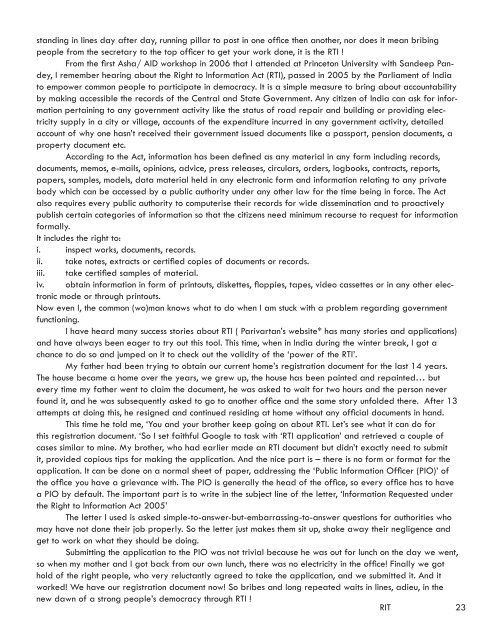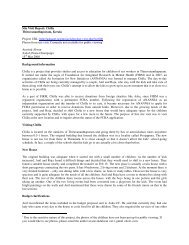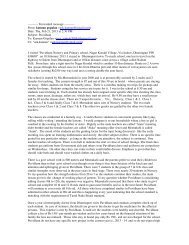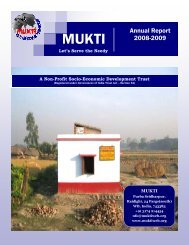Download pdf - Asha for Education
Download pdf - Asha for Education
Download pdf - Asha for Education
Create successful ePaper yourself
Turn your PDF publications into a flip-book with our unique Google optimized e-Paper software.
standing in lines day after day, running pillar to post in one office then another, nor does it mean bribing<br />
people from the secretary to the top officer to get your work done, it is the RTI !<br />
From the first <strong>Asha</strong>/ AID workshop in 2006 that I attended at Princeton University with Sandeep Pandey,<br />
I remember hearing about the Right to In<strong>for</strong>mation Act (RTI), passed in 2005 by the Parliament of India<br />
to empower common people to participate in democracy. It is a simple measure to bring about accountability<br />
by making accessible the records of the Central and State Government. Any citizen of India can ask <strong>for</strong> in<strong>for</strong>mation<br />
pertaining to any government activity like the status of road repair and building or providing electricity<br />
supply in a city or village, accounts of the expenditure incurred in any government activity, detailed<br />
account of why one hasn’t received their government issued documents like a passport, pension documents, a<br />
property document etc.<br />
According to the Act, in<strong>for</strong>mation has been defined as any material in any <strong>for</strong>m including records,<br />
documents, memos, e-mails, opinions, advice, press releases, circulars, orders, logbooks, contracts, reports,<br />
papers, samples, models, data material held in any electronic <strong>for</strong>m and in<strong>for</strong>mation relating to any private<br />
body which can be accessed by a public authority under any other law <strong>for</strong> the time being in <strong>for</strong>ce. The Act<br />
also requires every public authority to computerise their records <strong>for</strong> wide dissemination and to proactively<br />
publish certain categories of in<strong>for</strong>mation so that the citizens need minimum recourse to request <strong>for</strong> in<strong>for</strong>mation<br />
<strong>for</strong>mally.<br />
It includes the right to:<br />
i. inspect works, documents, records.<br />
ii. take notes, extracts or certified copies of documents or records.<br />
iii. take certified samples of material.<br />
iv. obtain in<strong>for</strong>mation in <strong>for</strong>m of printouts, diskettes, floppies, tapes, video cassettes or in any other electronic<br />
mode or through printouts.<br />
Now even I, the common (wo)man knows what to do when I am stuck with a problem regarding government<br />
functioning.<br />
I have heard many success stories about RTI ( Parivartan’s website* has many stories and applications)<br />
and have always been eager to try out this tool. This time, when in India during the winter break, I got a<br />
chance to do so and jumped on it to check out the validity of the ‘power of the RTI’.<br />
My father had been trying to obtain our current home’s registration document <strong>for</strong> the last 14 years.<br />
The house became a home over the years, we grew up, the house has been painted and repainted… but<br />
every time my father went to claim the document, he was asked to wait <strong>for</strong> two hours and the person never<br />
found it, and he was subsequently asked to go to another office and the same story unfolded there. After 13<br />
attempts at doing this, he resigned and continued residing at home without any official documents in hand.<br />
This time he told me, ‘You and your brother keep going on about RTI. Let’s see what it can do <strong>for</strong><br />
this registration document. ‘So I set faithful Google to task with ‘RTI application’ and retrieved a couple of<br />
cases similar to mine. My brother, who had earlier made an RTI document but didn’t exactly need to submit<br />
it, provided copious tips <strong>for</strong> making the application. And the nice part is – there is no <strong>for</strong>m or <strong>for</strong>mat <strong>for</strong> the<br />
application. It can be done on a normal sheet of paper, addressing the ‘Public In<strong>for</strong>mation Officer (PIO)’ of<br />
the office you have a grievance with. The PIO is generally the head of the office, so every office has to have<br />
a PIO by default. The important part is to write in the subject line of the letter, ‘In<strong>for</strong>mation Requested under<br />
the Right to In<strong>for</strong>mation Act 2005’<br />
The letter I used is asked simple-to-answer-but-embarrassing-to-answer questions <strong>for</strong> authorities who<br />
may have not done their job properly. So the letter just makes them sit up, shake away their negligence and<br />
get to work on what they should be doing.<br />
Submitting the application to the PIO was not trivial because he was out <strong>for</strong> lunch on the day we went,<br />
so when my mother and I got back from our own lunch, there was no electricity in the office! Finally we got<br />
hold of the right people, who very reluctantly agreed to take the application, and we submitted it. And it<br />
worked! We have our registration document now! So bribes and long repeated waits in lines, adieu, in the<br />
new dawn of a strong people’s democracy through RTI !<br />
RIT 23
















